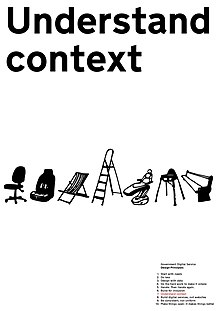Interpersonal Communication
Read this article, which explains interpersonal communication. Consider
the ways in which you can apply this knowledge in your own interactions.
4. Context


Understanding the context of a situation may lead to an awareness of necessary precautions.
Context
refers to environmental factors that influence the outcomes of
communication. These include time and place, as well as factors like
family relationships, gender, culture, personal interest and the
environment. Any given situation may involve many interacting contexts,
including the retrospective context and the emergent context. The
retrospective context is everything that comes before a particular
behavior that might help understand and interpret that behavior, while
the emergent context refers to relevant events that come after the
behavior. Context can include all aspects of social channels and
situational milieu, the cultural and linguistic backgrounds of the
participants, and the developmental stage or maturity of the
participants.
Situational milieu
Situational milieu can be
defined as the combination of the social and physical environments in
which something takes place. For example, a classroom, a military
conflict, a supermarket checkout, and a hospital would be considered
situational milieus. The season, weather, current physical location and
environment are also milieus.
To understand the meaning of what
is being communicated, context must be considered. Internal and external
noise can have a profound effect on interpersonal communication.
External noise consists of outside influences that distract from the
communication. Internal noise is described as cognitive causes of
interference in a communication transaction. In the hospital setting,
for example, external noise can include the sound made by medical
equipment or conversations had by team members outside of patient's
rooms, and internal noise could be a health care professional's thoughts
about other issues that distract them from the current conversation
with a client.
Channels of communication also affect the
effectiveness of interpersonal communication. Communication channels may
be either synchronous or asynchronous. Synchronous communication takes
place in real time, for example face-to-face discussions and telephone
conversations. Asynchronous communications can be sent and received at
different times, as with text messages and e-mails.
In a hospital
environment, for example, urgent situations may require the immediacy
of communication through synchronous channels. Benefits of synchronous
communication include immediate message delivery, and fewer chances of
misunderstandings and miscommunications. A disadvantage of synchronous
communication is that it can be difficult to retain, recall, and
organize the information that has been given in a verbal message,
especially when copious amounts of data have been communicated in a
short amount of time. Asynchronous messages can serve as reminders of
what has been done and what needs to be done, which can prove beneficial
in a fast-paced health care setting. However, the sender does not know
when the other person will receive the message. When used appropriately,
synchronous and asynchronous communication channels are both efficient
ways to communicate. Mistakes in hospital contexts are often a result of
communication problems.
Cultural and linguistic backgrounds
Linguistics
is the study of language, and is divided into three broad aspects: the
form of language, the meaning of language, and the context or function
of language. Form refers to the words and sounds of language and how the
words are used to make sentences. Meaning focuses on the significance
of the words and sentences that human beings have put together.
Function, or context, interprets the meaning of the words and sentences
being said to understand why a person is communicating.
Culture
is a human concept that encompasses the beliefs, values, attitudes, and
customs of groups of people. It is important in communication because of
the help it provides in transmitting complex ideas, feelings, and
specific situations from one person to another. Culture influences an
individual's thoughts, feelings and actions, and therefore affects
communication. The more difference there is between the cultural
backgrounds of two people, the more different their styles of
communication will be. Therefore, it is important to be aware of a
person's background, ideas and beliefs and consider their social,
economic and political positions before attempting to decode the message
accurately and respond appropriately. Five major elements related to
culture affect the communication process:

Communication diagram showing types of communication between cultures, including verbal and non-verbal communication.
- Cultural history
- Religion
- Value (personal and cultural)
- Social organization
- Language
Communication
between cultures may occur through verbal communication or nonverbal
communication. Culture influences verbal communication in a variety of
ways, particularly by imposing language barriers. Each individual has
their own languages, beliefs and values that must be considered. Factors
influencing nonverbal communication include the different roles of eye
contact in different cultures. Touching as a form of greeting may be
perceived as impolite in some cultures, but normal in others.
Acknowledging and understanding these cultural differences improves
communication.
In the health professions, communication is an
important part of the quality of care and strongly influences client and
resident satisfaction; it is a core element of care and is a
fundamentally required skill. For example, the nurse-patient
relationship is mediated by both verbal and nonverbal communication, and
both aspects need to be understood.
Developmental Progress (maturity)

Pie chart of verbal (20%) and non-verbal (80%) communication in infants.
Communication
skills develop throughout one's lifetime. The majority of language
development happens during infancy and early childhood. The attributes
for each level of development can be used to improve communication with
individuals of these ages.